The Brangwyn Panels
The British Empire Panels
Frank Brangwyn’ idyllic, fantastical landscape conceals a historical tragedy and the panels are a First World War memorial of great significance.’
It is this notion that inspired Marc Rees to create an ambitious, large-scale multimedia performance that links the First World War with historical and contemporary conflicts. For further in depth information on the panels fascinating story read the following article by Enora Le Pocreau commissioned by Now The Hero / Nawr Yr Arwr.
‘The inauguration of the Houses of Parliament in London in 1837 - built in pure Neo-Gothic style by architect Charles Barry - offered sculptors and painters the promise of prestigious commissions. This was an opportunity, which Brangwyn had sought for years. With the commission of the British Empire panels, Sir Frank Brangwyn saw an opportunity to revitalise his art and reach the pinnacle of his career. According to the Art Historian Clare Willsdon, as a response to the creation of the Gallery des Batailles by Louis Philippe at Versailles, a new School of British murals was to be created in Westminster. In this symbolic heart of British power, Prince Albert wanted to install a series of paintings capable of surpassing the continental style. During the 19th century Westminster’s patronage mirrored the German style, the Royal decision being the driving force of all projects. However, the coronation of King George V in 1910, marked the beginning of a new system – a system which passed control of artistic decisions onto the House of Lords.
After the First World War, all across Europe, many memorials and places of commemoration were created. The United Kingdom, however, did not yet share this commemorative mass culture, with the possible exception of Northern Ireland that feeds off a long tradition of commemorative murals. Six years after the end of the First World War, the House of Lords finally responded to the need for Great Britain to fill the artistic void of remembrance. The House of Lords then entrusted the creation of a war memorial in the Palace of Westminster to Lord Iveagh, a wealthy Irish man. Lord Iveagh, commissioned Frank Brangwyn to produce the mural paintings for the North and South walls of the Royal Gallery. Taught by the three most influential figures in design during the 1900s, Arthur Mackmurdo, William Morris and Siegfried Bing ; Lord Iveagh felt that Brangwyn was the most competent artist for the commission. In addition to his qualifications, Brangwyn had already completed a memorial for the First World War. He executed a crescent moon shaped painting for the Canadian War Memorial in Winnipeg and had previously been involved in a memorial project in Birmingham (Birmingham University War Memorial) which never saw the light. In 1926, Brangwyn presented two panels to Lord Iveagh: A Tank in Action [Fig. 1] and Heavy Gun in action.

These two panels depicted two battle scenes which showed the deconstruction of the figures, incorporating the codes of the Vorticist composition. Iveagh rejected these frescoes, which showed the reality of war in all its cruelty. Despite this rejection, Sir Frank Brangwyn was commissioned for a new scheme representing the different colonies of the British Empire. In this new project, Brangwyn aimed through iconographic choices, to show the British unity and solidity of the British Empire.
The only loyal supporter of Brangwyn's works was Lord Iveagh, but he knew that the iconographic and pictorial choices made by Brangwyn for the scheme, would not be understood by the Lords. In order to protect Brangwyn's works, Lord Iveagh created a tacit agreement on the first day of the commission. This agreement stated that there could be no interference in the work of the artist and the panels would not be examined before the scheme was fully complete. This pact was the only shield against the otherwise inevitable censorship to be placed on the scheme by the House of Lords. Sadly, in 1927 Lord Iveagh died. Weakened by the death of his patron and excluded from all discussions, Brangwyn was failed to impose his vision of a memorial valuing the Empire's contributions to victory and peace. On April the 3rd 1930, following the report of the Royal Fine Art Commission, a debate lead to the rejection of the British Empire Panels in the Royal Gallery. The Lords, who were more accustomed to social and political narrative frescoes, wanted to see historical paintings in Westminster, depicting the glory of the Empire. In order to explain the Lords decision, Lord Crawford, a conservative politician who favoured neo-classical art, wrote on the 7th march 1930 an article in the Daily News, where he vehemently expressed his opinion describing the panels as ''all tits and bananas'' he continues his rant:
Just Imagine, five feet long bananas, with grinning black monkeys looking over them, in a room like this, with its historic association. These new pictures might do very well for a night club ; they are certainly out of place here.
Mocking here the abundance of vegetation and the primacy given by the artist to the naked female body.
In 1930 with the birth of totalitarian movements, Europe was experiencing a wave of censorship and propaganda. Faced with the rise of fascism on the continent, artists and British intellectuals feared the control of artistic productions. Furthermore, unlike canvas painting, the panels, by their monumental format could not be included in the various exhibitions throughout the country: their immmovability reduced their exposure and the chance for the artist to gain support of the general public. Walter Benjamin wrote in 1927 that "history is divided into images, not stories'': it is the visual experience that creates the living memory ; people's thoughts are not abstract but based on concrete representation. By controlling pictorial representations the government controls History.
It would seem then that Brangwyn built the British Empire scheme in complete contrast to the six (unfinished & rejected) inital war themed panels. The violence of the early works, showing the war as the arbiter of life and death and depicting the dehumanisation of the fighting, gradually disappeared in the artists mind, to give birth to a new world in the British Empire panels. Lord Iveagh's disapproval of the first project seemed to have intellectually stimulated the artist. Brangwyn, then had a complete change of vision which materialised as a radical change of concept and strategy between the first and the second commission. In the first, he refers to a national art and modernity through a purely British style : Vorticism. In the second commission, he offers a look into the past and more international roots, looking towards William Morris and the Flemish
Schools. He changes from a narrative and documentary painting to a painting full of confusion and opacity where the form and the content become one. If modern war had to be painted in a modern way, the colonies and their beauty seem timeless. Brangwyn knows that once placed in the Palace of Westminster, his panels would take on a new meaning: they would gain a solemn dimension and collective vision.
These formal and intellectual changes between the first and second commission, invite us to ask ourselves how the artist questions the images produced at the extent of the trauma? Why does Brangwyn give us an idyllic landscape which actually conceals a historical tragedy?
It is possible to think that the work of Sir Brangwyn is a testament to his reflection on the role of the memorial. The murals will serve no trauma and do not fulfil their commemorative role, they are a celebration of the beauty of wildlife and tropical flora, an image of a lost paradise that would be the British Empire. After the atrocities of war, the decor would be a way for the artist to re-enchant the world and return to nature, good and benevolent. Brangwyn aspires, through his status as an artist, to break away from the social constraints of the masses ; to freely propose a new commemorative imagery, following the path opened in 1918, just after the Great War, with Monet's Nymphéas [Fig. 2] painting.

Indeed Monet gave a new meaning to his painting by offering it to the French state. Monet introduces there a new model ; his painting becomes a quest for the common good, affirming that no representation of the fighting would be up to the level of atrocities experienced by the soldiers. For Brangwyn, ''the men whom the panels would commemorate had died to save Britain and the Empire, and so it seems natural to portray the people, the flowers, the fruits and the fauna of the far-flung territories of British dominion"; The artist here fully embraces Monet's new conception of a memorial and its' purpose. If the processing and the iconography, from first to the second commission, seem distant to us, for Brangwyn, the first mission seems to remain the same-
To honour the men and women of the Empire, who gave their lives to help preserve its stability. In the second set of panels Brangwyn adds a new dimension, an over abundance of fauna and flora that creates a lush mask hiding that the true subject of his painting remains the tribute to the dead for their country.
In this context, where the concept of nationality is difficult to perceive, Brangwyn painted the ethnic mix of the British Empire, as in the third panel representing Canada [Fig. 3], we can see two European-type men, an African child and three women of Asian descent working together, rejecting the idea that commemoration has to be an act of nationalism.
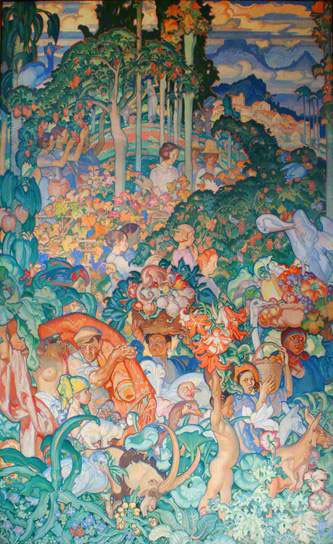
Between the two Wars the question of commemoration and remembrance is a central issue. Brangwyn is looking for a pictorial alternative to those conventional Memorials by confusing and suffocating the viewer.
The British Empire panels were designed by Brangwyn as a unifying medium of collective memory; they stand as a vector between men and their history in order to reunite the British territory. By refusing to produce a glorious epic painting, where the allegory mixes with the worship of national heroes, Brangwyn seems to have gradually adopted an approach tending to favour the universal good, revealing the scope of collective commemoration and fading at the extent of the event.
The image has an emotional under dimension, inviting the viewer to read between the lines, between dream and reality. The panels of the British Empire offer a viewer an ideal vision of the colonies, representing the world as it should be and not as it is. Painting a dream rather than reality allows Brangwyn to open the field of possibilities. The artist does not represent the "real" : far away from the temptation of painting visual illusions and lying to the viewer, Brangwyn makes the dream another way to access a certain truth. This world built from scratch by the artist, remains firmly rooted in a concept and an imagination inherited from the nineteenth century, when the dream was indeed perceived as the opposite of rationality and seen as the place of the reconquest of the lost innocence, facing the dehumanisation of the industrial society. The dream also sometimes takes the form of nightmare, which then releases the painful realities.
In the light of William Blake's affirmation of the dream as the inverse of blindness, a new reading of the the British Empire panels seems possible. Indeed, Brangwyn meets Blake in the affirmation of a profound belief in the organic unity of the world -nature is seen as a benevolent place where everyone has the right to dream-. However, paradoxically in the panels it seems like the nature wants to swallow humans. It is possible to observe a change in the number of characters in each panel of the British Empire scheme, from the Canadian panel to the Indian Panel, the paintings are built around a large number of figures which slowly dwindle in number to the point where there are only two or three protagonists, increasingly buried under vegetation. In the Kingdom of Siam panel [Fig. 4] the artist completely eliminates the human figure. It is within the absorption of the human element that Brangwyn disrupts the spectator.
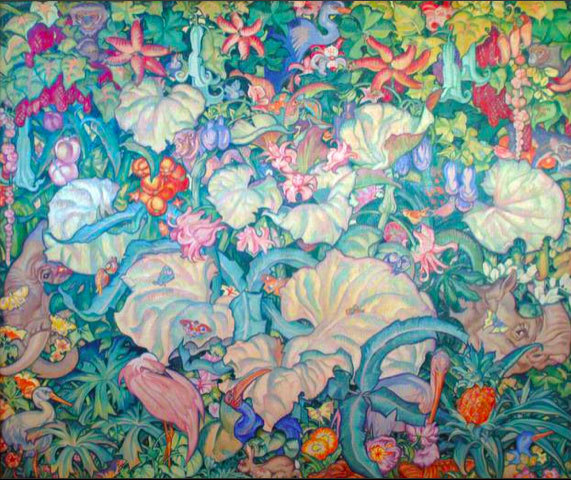
The disruption reveals another dimension of the work, some figures look toward the viewer with a troubled and piercing look, challenging us. Faced with the lack of space and time markers, the image offers no escape, no outward clue to the viewer; In this plant based decor fashioned from scratch, the dream seems to take on a new strange dimension ; the image is stifling, nature is no longer the place of freedom but leans towards confinement, it imprisons the characters. The viewer is confused by the unreality of this nature: What is it hidden behind this profusion of vegetation? For Baudelaire, the modern man is cleaved, he will always be marked since he was thrown out of Eden. The human tragedy therefore is to try to find again this lost paradise. It is around this central idea of a lost paradise that Brangwyn articulates his point.
With the British Empire Panels, Brangwyn aspired to create a universal message by using a new aesthetic language. The war was total and international, touching all peoples lives; the artist responds to the chaos and destruction with a profusion of ornaments, providing an understanding of the world through an aesthetic experience.
The public dimension of the work, in a building symbolic of the British nation, invites the artist to produce a speech that must be collective. The art Historian Clare Willsdon stresses that ''Of the British muralist of the Early twentieth century, it was perhaps to be Brangwyn above all who developed the art of 'suggestion' and ' melodies' in form and colour to its full potential'', Sir Frank Brangwyn must also face the challenges of the specificity of realising a ''Grand Décor'' which is to immerse the viewer in the work. Brangwyn creates a complex dialogue between the spectator and the painting, immersing us in the middle of a world, a lost paradise, done in bright colours and curved lines, offering to the viewer a more physical than intellectual experience. The painting is no longer there just to tell a story but it becomes a place to experience made of shapes and colours. The saturation of the compositions do not allow the eye to find any escape, Brangwyn pushes the viewer into a claustrophobic feeling that is accentuated as the vegetation becomes more dense from the first to the final panel. The artist creates instability brought by the colourful vibrations and changes in formats which, combined with the curve, induces vertigo; a hallucinogenic effect. Brangwyn paints the idea of an Empire without a beginning or an end, eternal, where the sun never sets. He goes back to nature in order to eliminate any social divisions. As opposed to his predecessors hung in the Palace of Westminster he refused to produce a scholarly painting. By positioning himself in a utopian posture, creating a painting accessible to all, he wants to use a language that aims to democratise high art. Robert Lamb described his friend as "a Christian Socialist of an almost Tolstoyan stamp'', Brangwyn, as an old student of William Morris followed the ideals in the tradition of the humanist thinkers of the nineteenth century. Relative to his convictions, Brangwyn developed a painting promoting equality between man, a syncretism of cultures, showing his belief in mankind.
Brangwyn, in the British Empire panels celebrates nature in its diversity and its infinite richness. Rodney Brangwyn says in his book that his grandfather, Frank Brangwyn cultivated in the garden of his home in Hammersmith, many exotic plants brought back from his travels in the East. His interest in horticulture and plants certainly born from contact with his master, William Morris, who likewise grew many species of plants in the garden of the Red House.
The representation of nature at first can seem wild but is actually perfectly controlled. Most of the species are identifiable; for example we can see the ixora flower from Asia, or the gloxinia tropicale from America. It also provides domestic flowers well known in Europe: like chrysanthemums and camellias. The Plants from the Empire are the symbol of a scientific but also industrial revolution. This idea is developed in the Canadian panel [Fig. 3 & 5] where two men are using a saw for cutting the trunk of a gigantic Eucalyptus tree - the Eucalyptus wood with its fast-growing capacity - was planted in many colonies as building material and firewood for the rapidly growing working populations. At the time British industry feeds almost entirely on natural products and imports. In the Indian procession panel, the palm tree, represented in the background was in great demand; Brangwyn knew their importance, palm oil was in fact used as a lubricant for industrial machinery. Brangwyn's choice of plants was supported by a knowledge of botany and the scientific applications of plants across the Empire. The panels are presented as a fertile garden and Brangwyn as it's landscape designer, selects appropriate plants and takes care of their characteristics.
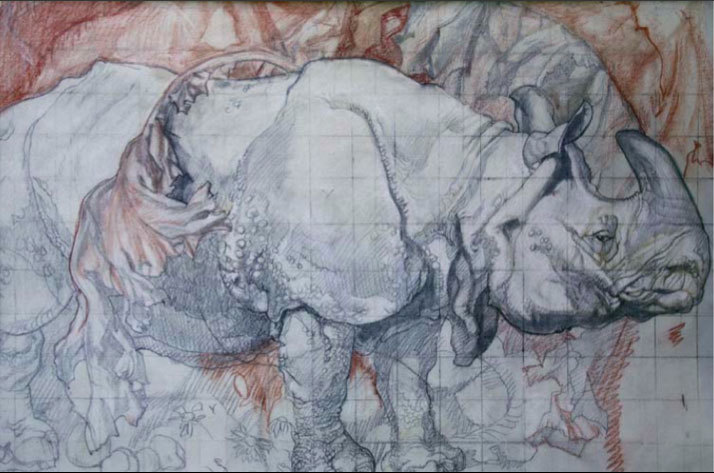
In 1904, a reporter from The Evening News already took notice of Brangwyn's ability to make drawings from life: "he takes his inspiration from life and not books". Brangwyn had probably been to the Kew Gardens in London which already contained the most important collection of plants in the World or to the Museum of Economic Botany newly opened in 1847, to study the plants and execute a large number of drawings.

For the purposes of the Indian panels series, it seems that Brangwyn had been to London Zoo, in order to draw exotic and impressive animals like the rhinoceros [FIg. 6] and elephant [Fig. 7], which he will then hide within the vegetation in his paintings. During the preparatory phase of research, the artist created a repertoire of shapes and patterns that he reused later in the panels.
Photography is also an integral part of the British Empire panels construction process. Around 1990s, the photographer and American Art merchant Paul Cava, discovered Frank Brangwyn's important photographic collection: over 350 photographs. It seems that for the British Empire Panels, the artist had only made 22 shots, the images that have survived were made with a Kodak camera ; easy to use and inexpensive offering Brangwyn the chance to design a new relationship with reality and time. For the needs of the British Empire Panels, he brought several models to his workshop in Ditchiling (Sussex). However, contrary to his habit, he did not use professional models, rather looking for characters with an atypical look.
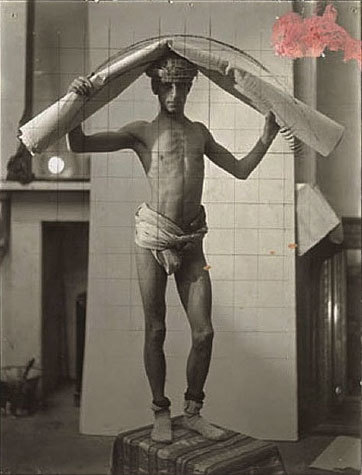
As a preparatory study for the third panel of Canada Brangwyn photographed Marco Yafrate [Fig. 8] an Italian chestnut seller, with a thin body, highlighted on the photograph by the magnitude of the load he carries on his head. Furthermore for the first time he used ethnic models and invited them to stay with him in Ditchiling including a West Indian wrestler and his three sons as well as a servant native from Barbados [Fig. 9], who he described as a "Grand Rubenesque lady " because of her imposing physique.
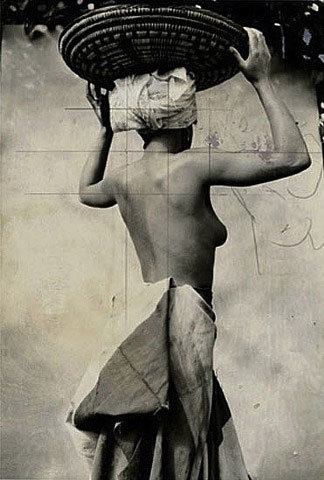
Photography is for Brangwyn the first point of a larger reflection, the ideas of the artist will pass slowly through the preparatory drawings to the final dimension of the work. The photographs are seen by the artist as a place to explore different poses, they are here as a memory aid, but in no way a substitute for the preparatory drawings. Accumulating both photographs and preparatory studies, Brangwyn managed to create a real image repertoire, which is the starting point of the artist's experimentation, the first step in the design of his work. His practice has an ambivalence that turns into a complementarity: at first photographic precision, progressively deconstructing the motifs with each step of preparatory drawings ending in total reappropriation.
The rejection of the Empire panels by the House of Lords did not mark the ending point of Brangwyn's trajectory that continued an international career and received other prestigious commissions. By their magnitude and their ambition, the British Empire murals were at the heart of the artist's concerns during more than five years until the panels arrives in Swansea in 1933. The codes that he created in the panels will then persist in the rest of his work. The Westminster panels will become an obsession for the artist. In his following commission he accumulated references to the Empire Panels using direct quotations, repeating the same colours and the same pictorial themes, coming close to outright plagiarism of his own work. In 1930, just following the judgment of the Lords, Brangwyn received a commission for the decor of a new ship, the SS-Empress of Britain. Brangwyn, as a famous multidisciplinary artist, was invited to design the entire ship's décor including several decorative panels.

This boat was unfortunately sunk by a German submarine in 1940, however, a unique photograph of the decor survived, in this photograph we can see five decorative panels entitled A Vision of the Lavish Gifts of Mother Earth, where women with robust bodies are blossoming in the middle of lush vegetation. A series of studies [Fig. 10] for these panels demonstrate a direct continuity with the panels of Westminster : plant profusion, the same sinuous curves and dramatic colours. In one drawing it is possible to recognise the figure of the woman who is carrying sunflowers, already present in the centre of the first Indian panel [Fig. 11] this women later becomes a recurring figure in Brangwyn's work.

Through the décor of The SS-Empress of Britain Brangwyn found a way for his art to travel and give it a new international audience. Bolstered by his international reputation, in 1934 Brangwyn received a commission from John D Rockefeller for a monumental panel in the new Rockefeller Center in New York. The panel depicts two nude women, one seen from the back lazing in a profusion of fruits the other seen from the front exposes her breast. We can once more see the primacy of the curves and the Hide and Seek game typical of the Empire panel's composition. Brangwyn then painted a decor entitled, The Printed World Makes the People of the World One [Fig 12], for the lobby of the Odhams Press company in London. Again Brangwyn is looking towards the Empire panels for inspiration, reusing the same pictorial codes, the serpentine line and the vivid harmonies of colour and as always the recurrent figure of the basket carrier is present as well as the half naked fruit pickers, illustrating the abundance and fertility. As a banner Brangwyn advocates sustainability and the dissemination of the pictorial codes introduced in Westminster, symbols of protest against the conservative Lords.
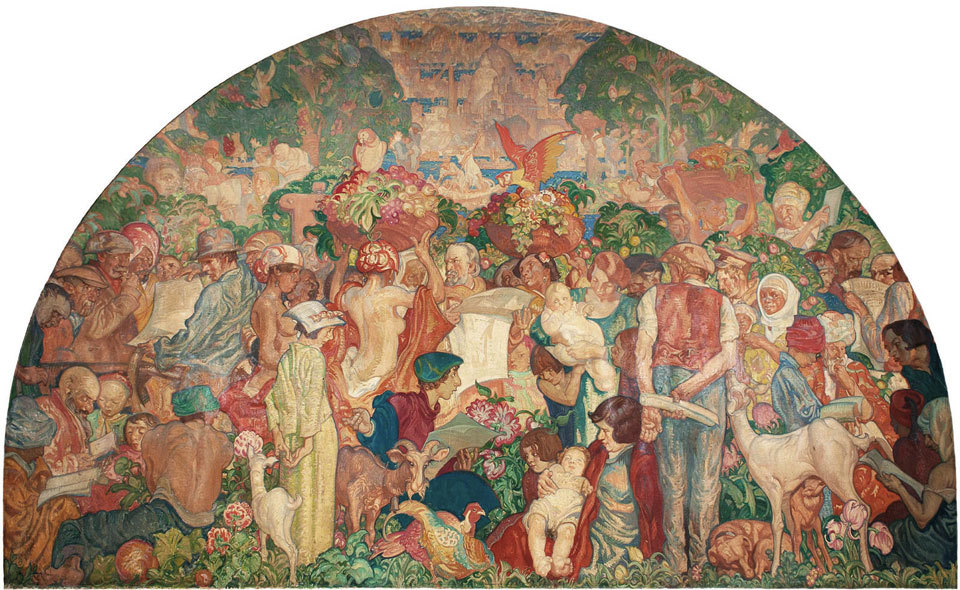
If during the nineteenth century David Friedrich was painting the tragedy of the landscape, Sir Brangwyn with the British Empire panels paints the tragedy hidden behind the scenery.
What the British were unable to produce through historical painting, they expressed through painting landscapes, following the path opened by Turner and Constable. We can assume that with its pictorial and iconographic choices, Brangwyn has the will to renew the visual language of the memorial in England. The viewer discovers that behind the beauty of wildlife hides repressed images: the horrors of war and colonisation. At Westminster, the artist began a de-ranking of the motif and drowns the subject into the background; the compositions are based on a set of plastic masses, affirming the two dimensions of the panel. It invites the viewer to live a daydream by abolishing all temporality and not limiting any border between myth and reality. This refusal to produce a narrative painting that would tell the story of colonisation, can be linked to a reminiscence of his formative years with William Morris, where he learned that for a successful décor, the primacy of the from over the subject. Ambivalently between tradition and the avant- garde, Brangwyn produced an art constantly shifting with the times, trying to renew the angles of approach, he wants to forget the devastated pictures of the Great War to substitute a blaze, a gushing burst of life.’
Enora Le Pocreau